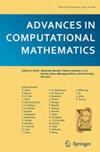有限正则函数傅里叶展开的局部行为
IF 1.7
3区 数学
Q2 MATHEMATICS, APPLIED
引用次数: 0
摘要
根据傅立叶投影近似点误差的明确公式,并应用 van der Corput 型定理,建立了不同光滑度周期函数的最佳收敛速率。结果表明,光滑部分的收敛速率比奇异点处的衰减速率高一个数量级。此外,它还取决于与奇点的距离。大量的数值实验证明了与估计值的完美吻合。本文章由计算机程序翻译,如有差异,请以英文原文为准。
Local behaviors of Fourier expansions for functions of limited regularities
Based on the explicit formula of the pointwise error of Fourier projection approximation and by applying van der Corput-type Lemma, optimal convergence rates for periodic functions with different degrees of smoothness are established. It shows that the convergence rate enjoys a decay rate one order higher in the smooth parts than that at the singularities. In addition, it also depends on the distance from the singularities. Ample numerical experiments illustrate the perfect coincidence with the estimates.
求助全文
通过发布文献求助,成功后即可免费获取论文全文。
去求助
来源期刊
CiteScore
3.00
自引率
5.90%
发文量
68
审稿时长
3 months
期刊介绍:
Advances in Computational Mathematics publishes high quality, accessible and original articles at the forefront of computational and applied mathematics, with a clear potential for impact across the sciences. The journal emphasizes three core areas: approximation theory and computational geometry; numerical analysis, modelling and simulation; imaging, signal processing and data analysis.
This journal welcomes papers that are accessible to a broad audience in the mathematical sciences and that show either an advance in computational methodology or a novel scientific application area, or both. Methods papers should rely on rigorous analysis and/or convincing numerical studies.

 求助内容:
求助内容: 应助结果提醒方式:
应助结果提醒方式:


